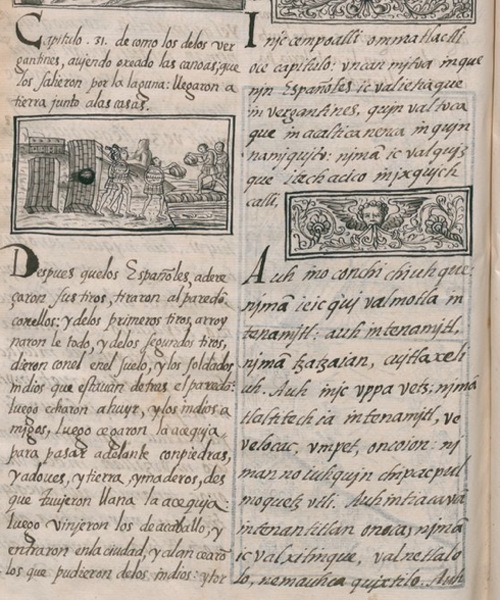Folio 56 verso, cont.
Translations and Transcriptions
Spanish Translation
[Translation of the Nahuatl into Spanish by Fr. Bernardino de Sahagún; transcription of the Spanish (left-hand column) by James Lockhart:] [f. 56v., cont.] Capitulo .31. de como los de vergantines, auiendo oxeado las canoas; que los salieron por la laguna: llegaron a tierra junto a las casas. [Aquí: un dibujo] Despues que los Españoles, adereçaron sus tiros, tiraron al paredō con ellos: y de los primeros tiros, arroynaronle todo, y de los segundos tiros, dieron con el en el suelo, y los saldados indios que estauan detras el paredō: luego echaron a huyr, y los indios amigos, luego cegaron la acequia para pasar adelante con piedras, y adoues, y tierra, y maderos, desque tuuieron llana la acequia: luego vinieron los de a caballo, y entraron en la ciudad, y alancearō los que pudieron de los indios: y tor
English Translation
[Translation of the Nahuatl (right-hand column) by James Lockhart:] Thirty-first chapter, where it is said how the Spaniards came with the brigantines, pursuing those who were in boats. When they were done contending with them, they drew close and reached all the houses. And when they had finished adjusting [the guns], they shot at the wall. The wall then ripped and broke open. The second time it was hit, the wall went to the ground; it was knocked down in places, perforated, holes were blown in it. Then, like the other time, the road stood clear. And [Translation of the Spanish (left-hand column) by James Lockhart:] Chapter Thirty-one, of how the brigantines, having scattered the canoes that went out against them on the lake, came to land next to the houses. After the Spaniards had adjusted their cannon, they shot at the barrier with them. With the first volley they ruined it all, and with the second they knocked it to the ground. Then the Indian soldiers who were behind the barrier began to flee, and the friendly Indians filled in the canal with stones, adobe, earth, and timbers in order to be able to go forward. When they had the canal filled up level, the horsemen came and entered the city, lancing the Indians that they could, then
Analytic Transcription
[Transcription of the Nahuatl (right-hand column) by James Lockhart:] [f. 56v., cont.] Inic cempoalli ommatlactli oce capitulo: vncan mitoa in quenin Españoles ic valietiaque in vergantines, quinvaltocaque in acaltica nenca in quinnamiquito: nimā ic valquizque itech acico in ixquich calli. Auh in oconchichiuhque: nimā ie ic quivalmotla in tenamitl: auh in tenamitl nimā tzatzaian, cuitlaxeliuh. Auh inic vppa vetz; nimā tlaltitech ia in tenamitl, vevelocac, vmpet, oncoion: niman no iuhquin chipacpul moquetz vtli. Auh in tiacavā in tenantitlan onoca, nimā ic valxitinque, valnetlalolo, nemauhcaquixtilo. Auh
Image

Spanish Translation
[Translation of the Nahuatl into Spanish by Fr. Bernardino de Sahagún; transcription of the Spanish (left-hand column) by James Lockhart:] [f. 56v., cont.] Capitulo .31. de como los de vergantines, auiendo oxeado las canoas; que los salieron por la laguna: llegaron a tierra junto a las casas. [Aquí: un dibujo] Despues que los Españoles, adereçaron sus tiros, tiraron al paredō con ellos: y de los primeros tiros, arroynaronle todo, y de los segundos tiros, dieron con el en el suelo, y los saldados indios que estauan detras el paredō: luego echaron a huyr, y los indios amigos, luego cegaron la acequia para pasar adelante con piedras, y adoues, y tierra, y maderos, desque tuuieron llana la acequia: luego vinieron los de a caballo, y entraron en la ciudad, y alancearō los que pudieron de los indios: y tor
English Translation
[Translation of the Nahuatl (right-hand column) by James Lockhart:] Thirty-first chapter, where it is said how the Spaniards came with the brigantines, pursuing those who were in boats. When they were done contending with them, they drew close and reached all the houses. And when they had finished adjusting [the guns], they shot at the wall. The wall then ripped and broke open. The second time it was hit, the wall went to the ground; it was knocked down in places, perforated, holes were blown in it. Then, like the other time, the road stood clear. And [Translation of the Spanish (left-hand column) by James Lockhart:] Chapter Thirty-one, of how the brigantines, having scattered the canoes that went out against them on the lake, came to land next to the houses. After the Spaniards had adjusted their cannon, they shot at the barrier with them. With the first volley they ruined it all, and with the second they knocked it to the ground. Then the Indian soldiers who were behind the barrier began to flee, and the friendly Indians filled in the canal with stones, adobe, earth, and timbers in order to be able to go forward. When they had the canal filled up level, the horsemen came and entered the city, lancing the Indians that they could, then
Analytic Transcription
[Transcription of the Nahuatl (right-hand column) by James Lockhart:] [f. 56v., cont.] Inic cempoalli ommatlactli oce capitulo: vncan mitoa in quenin Españoles ic valietiaque in vergantines, quinvaltocaque in acaltica nenca in quinnamiquito: nimā ic valquizque itech acico in ixquich calli. Auh in oconchichiuhque: nimā ie ic quivalmotla in tenamitl: auh in tenamitl nimā tzatzaian, cuitlaxeliuh. Auh inic vppa vetz; nimā tlaltitech ia in tenamitl, vevelocac, vmpet, oncoion: niman no iuhquin chipacpul moquetz vtli. Auh in tiacavā in tenantitlan onoca, nimā ic valxitinque, valnetlalolo, nemauhcaquixtilo. Auh
Image
